Description of Pore Structure of Carbonate Reservoirs Based on Fractal Dimension
Abstract
:1. Introduction
2. Geological Background and Experiments
3. Experimental Methods and Procedures
3.1. MIP
3.2. NMR
4. Methodology and Materials
4.1. Fractal Dimension Based on MIP
4.2. Fractal Dimension Based on NMR
4.3. Pore Structure Test Materials
5. Results
5.1. The Calculation of Plane Fractal Dimension (DBC)
5.2. The Calculation of the Fractal Dimension of MIP (DMIP)
5.3. The Calculation of the Fractal Dimension of NMR (DNMR)
5.4. The Relationship between the Fractal Dimensions of Different Types
6. Discussion
6.1. The Relationship between Fractal Dimension and Microscopic Characteristics of Reservoirs
6.2. The Effect of Fractures on Fractal Dimension
6.3. The Influence of Fractal Dimension on Reservoir Physical Properties
7. Conclusions
- A fractal dimension can comprehensively describe the complexity and multi-scale of the microscopic structure of reservoirs, and there is a clear correlation between different microscopic parameters and fractal characteristics. The correlation between the pore shape factor and separation coefficient is the strongest with fractal dimension.
- The fractal dimension of carbonate reservoirs shows a multi-segmented characteristic with pore throat scale. Analyzing the relationship between different scale fractal dimensions and permeability, it is found that the mesoporous pore throat characteristics have the greatest impact on reservoir properties.
- This paper proposes a permeability prediction model for carbonate reservoirs considering fractal dimensions. The calculation results have a significantly improved agreement compared with traditional methods; they provide a theoretical basis for predicting the absolute permeability of fractured carbonate rocks in dual media.
Author Contributions
Funding
Data Availability Statement
Conflicts of Interest
Nomenclatures
| Identification | Definition | Units |
| a | Proportionality constant | Dimensionless |
| Dp | Fractal dimension of pore | Dimensionless |
| Df | Fractal dimension of fracture | Dimensionless |
| DBC | Plane fractal dimension | Dimensionless |
| DMIP | Fractal dimension of MIP | Dimensionless |
| DNMR | Fractal dimension of NMR | Dimensionless |
| F | Shape factor | Dimensionless |
| K | Core permeability | mD |
| l | Fracture length | m |
| lmax | Maximum fracture length | m |
| lmin | Minimum fracture length | m |
| Nt | Number of fractures | Unit |
| P(r) | Pore throat radius distribution density function | |
| pc | Capillary pressure | MPa |
| r | Pore throat radius | μm |
| rmax | Maximum pore throat radius | μm |
| rmin | Minimum pore throat radius | μm |
| S | Pore throat volume fraction | Decimal |
| SHg | Mercury saturation | Decimal |
| ST | Pore volume fraction with relaxation time less than T2 | Decimal |
| T2 | Transverse relaxation time | ms |
| T2max | Maximum transverse relaxation time | ms |
| V(<r) | Pore throat volume with radius less than r | μm3 |
| V | Total pore throat volume | μm3 |
| τ | Tortuosity | Dimensionless |
| φ | Core porosity | % |
| φMIP | Mercury Intrusion Porosimetry porosity | % |
| φNMR | Nuclear Magnetic Resonance porosity | % |
| ρ | Surface relaxivity | μm/ms |
| θ | Wetting contact angel | ◦ |
| σ | Surface tension | MPa |
References
- Liu, Y.H.; Tian, Z.Y.; Xu, Z.Y. Based on the fractal characteristics of carbonate reservoir pore structure. J. Quant. Eval. Lithol. Reserv. 2017, 29, 97–105. [Google Scholar] [CrossRef]
- Wu, G.M.; Li, X.Z.; He, Y.F.; Gao, S.S.; Liu, H.X. Fractal characteristics of T2 spectrum of carbonate reservoir core: A case study of Anyue Gas field. Sci. Technol. Eng. 2015, 15, 55–59. [Google Scholar]
- Ma, S.Z.; Niu, D.L.; Wen, H.J.; Zhang, Y.; Wang, H.P.; Zhang, J.Y. Reservoir classification and Evaluation based on rock pore structure. J. Heilongjiang Univ. Sci. Technol. 2016, 26, 414–421. [Google Scholar] [CrossRef]
- Sun, L.J. A new method to study the pore spatial structure characteristics of sandstone. Pet. Geol. Oilfield Dev. Daqing 2002, 21, 29–31. [Google Scholar]
- Ding, Q.; Cheng, J.; Yang, B.; Jin, Z.X.; Liu, F.; Zhao, Z.W.; Yu, J.W. Quantitative characterization and classification of pore structure of Chang 4+5 Member in Block Hu 154, Ordos Basin. Xinjiang Pet. Geol. 2021, 42, 410–417. [Google Scholar] [CrossRef]
- Huang, Y.M.; Richard, C. Pore Throat Structure and Fractal Characteristics of Tight Sandstone Reservoirs: A Case Study of Upper Montney Formation in Block A in Western Canada Sedimentary Basin. Xinjiang Pet. Geol. 2021, 42, 506–513. [Google Scholar] [CrossRef]
- Ge, X.B.; Li, J.J.; Lu, S.F.; Cheng, F.W.; Yang, D.X.; Wang, Q. Characterization of micro-pore structure of tight sandstone reservoir based on fractal theory: A case study of tight sandstone reservoir in Jizhong Depression. Lithol. Reserv. 2017, 29, 106–112. [Google Scholar] [CrossRef]
- Wu, H.; Liu, Y.; Ji, Y.L.; Zhang, C.L.; Chen, S.; Zhou, Y.; Du, W.; Zhang, Y.Z.; Wang, H. Fractal characteristics of pore-throat of tight gas reservoir and its relationship with seepage: A case study of Member 8 of Xiashihezi Formation, Ordos Basin. Acta Sedimentol. Sin. 2017, 35, 151–162. [Google Scholar] [CrossRef]
- Wang, Z. Study on classification of medium-low porosity and permeability reservoirs based on fractal characteristics. Mar. Geol. Front. 2021, 37, 78–84. [Google Scholar] [CrossRef]
- Krohn, C.E. Fractal measurements of sandstone, shales and carbonates. Geophys. Res. 1988, 93, 3297–3305. [Google Scholar] [CrossRef]
- Yan, J.P.; He, X.; Geng, B.; Li, X.W.; Guo, H.M. Evaluation method of pore structure of low permeability sandstone reservoir based on fractal theory. Well Logging Technol. 2017, 41, 345–352+377. [Google Scholar] [CrossRef]
- Su, H.B.; Zhang, S.M.; Sun, Y.H.; Yu, J.B.; Yang, M.L.; Meng, W.; Wang, Y.; Yu, M.L. Oil-water relative permeability model of low permeability reservoir based on fractal theory. Pet. Geol. Recovery Effic. 2020, 27, 67–78. [Google Scholar] [CrossRef]
- Li, Y.D.; Dong, P.C.; Zhang, H.; Cao, N.; Wang, Y. Study on apparent permeability of shale matrix based on fractal theory. Pet. Geol. Recovery Effic. 2017, 24, 92–99+105. [Google Scholar] [CrossRef]
- Cheng, Y.Y.; Guo, C.Q.; Chen, P.Y.; Shi, H.D.; Tan, C.Q.; Cheng, M.W.; Xing, Y.Z.; Luo, X. Stress sensitivity of carbonate gas reservoirs and its microscopic mechanism. Pet. Explor. Dev. 2023, 50, 166–174. [Google Scholar] [CrossRef]
- Gong, Y.J.; Liu, S.B.; Zhao, M.J.; Xie, H.B.; Liu, K.Y. Characterization of micro pore throat radius distribution in tight oil reservoirs by NMR and high pressure mercury injection. Pet. Geol. Exp. 2016, 38, 389–394. [Google Scholar]
- Cheng, Y.Y.; Feng, Z.; Guo, C.Q.; Chen, P.Y.; Tan, C.Q.; Shi, H.D.; Luo, X. Links of hydrogen sulfide content with fluid components and physical properties of carbonate gas reservoirs: A case study of the right bank of Amu Darya. Turkmenistan 2022, 10, 910666. [Google Scholar] [CrossRef]
- Wu, J.G.; Yuan, Y.; Niu, S.Y.; Wei, X.F.; Yang, J.J. Multiscale characterization of pore structure and connectivity of Wufeng-Longmaxi shale in Sichuan Basin, China. Mar. Pet. Geol. 2020, 120, 104514. [Google Scholar] [CrossRef]
- He, C.Z.; Hua, M.Q. Fractal geometry description of reservoir pore structure. Oil Gas Geol. 1998, 19, 17–25. [Google Scholar]
- Xu, P.; Li, C.; Qiu, S.; Sasmito, A. A fractal network model for fractured porous media. Fractals 2016, 24, 1650018. [Google Scholar] [CrossRef]
- Miao, T.J.; Yu, B.M.; Duan, Y.; Fang, Q. A fractal analysis of permeability for fractured rocks. Int. J. Heat. Mass. Transf. 2015, 81, 75–80. [Google Scholar] [CrossRef]
- Xu, Z.X.; Guo, S.B.; Qiao, H.; Li, H.M. Fractal characteristics of pore structure of shale gas reservoir. Unconv. Oil Gas 2014, 1, 20–25. [Google Scholar]
- Dunn, K.J.; Bergman, D.J.; Latorraca, G.A. Nuclear Magnetic Resonance Petrophysical and Logging Application; Elsevier Science Ltd.: Amsterdam, The Netherlands, 2002. [Google Scholar]
- Behroozmand, A.A.; Keating, K.; Auken, E. A review of the principles and appli cations of the NMR technique for near-surface characterization. Surv. Geophys. 2015, 36, 27–85. [Google Scholar] [CrossRef]
- Wei, D.; Gao, Z.Q.; Zhang, C.; Fan, T.L.; Karubandika, G.M.; Meng, M.M. Pore characteristics of the carbonate shoal from fractal perspective. J. Pet. Sci. Eng. 2019, 174, 1249–1260. [Google Scholar] [CrossRef]
- Xiao, D.S.; Lu, S.F.; Lu, Z.Y.; Huang, W.B.; Gu, M.W. Combining nuclear magnetic resonance and rate-controlled porosimetry to probe the pore-throat structure of tight sandstones. Pet. Explor. Dev. 2016, 43, 961–970. [Google Scholar] [CrossRef]
- Su, J.L.; Sun, J.M.; Wang, T.; Zhang, S.W. An improved method for evaluating reservoir pore structure using NMR logging data. J. Jilin Univ. (Earth Sci. Ed.) 2011, 41 (Suppl. S1), 380–386. [Google Scholar] [CrossRef]
- Ge, X.M. Characterization of Pore Structure and Fine Logging Evaluation of Heterogeneous Clastic Reservoir; China University of Petroleum (East China): Qingdao, China, 2013. [Google Scholar]
- Cheng, G.X.; Liu, Y.R.; Guo, N.; Wang, A.P.; Chang, H.Y.; Zhang, T.J. Fractal characterization of cast thin sections: A case study of Kunbei New Area, Qaidam Basin. Lithol. Reserv. 2016, 28, 72–76+87. [Google Scholar] [CrossRef]
- Lesniak, G.; Such, P. Fractal aproch, analysis of images and diagenesis in pore space rvaluation. Nat. Resour. Res. 2005, 14, 317–324. [Google Scholar] [CrossRef]
- Costa, A. Permeability-porosity relationship: A reexamination of the Kozeny-Carman equation based on a fractal pore-space geometry assumption. Geophys. Res. Lett. 2006, 33, L02318. [Google Scholar] [CrossRef]



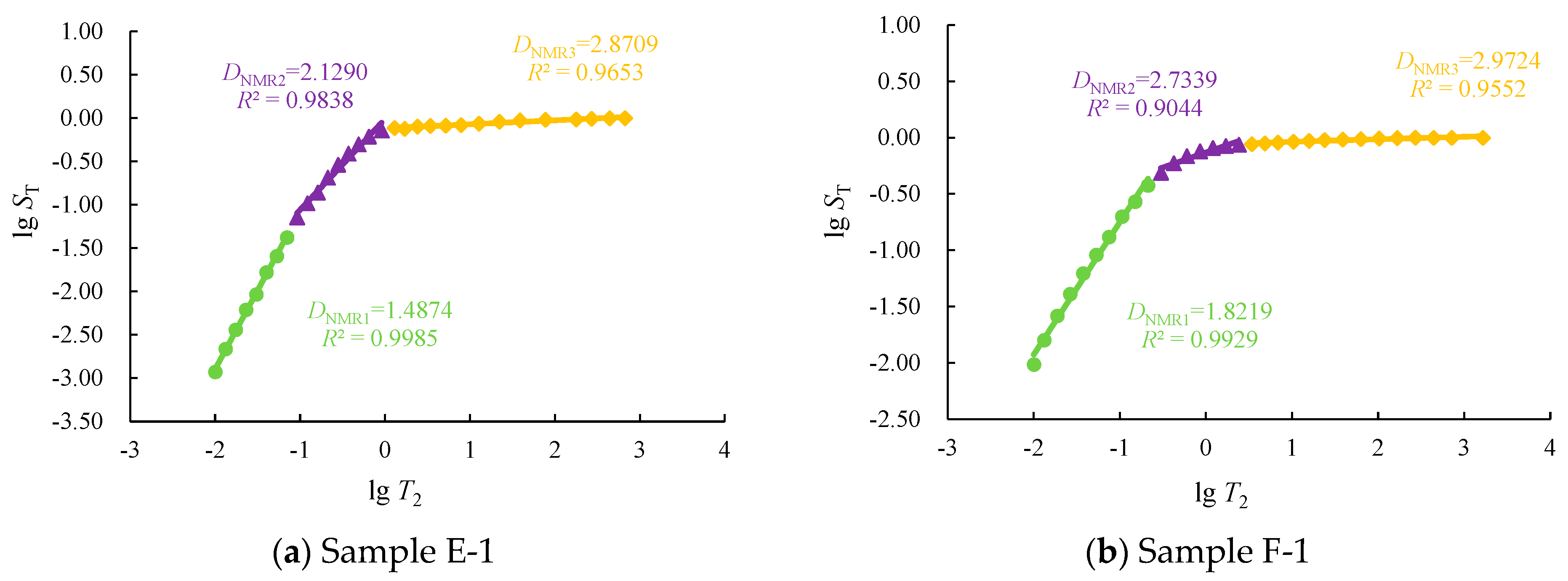
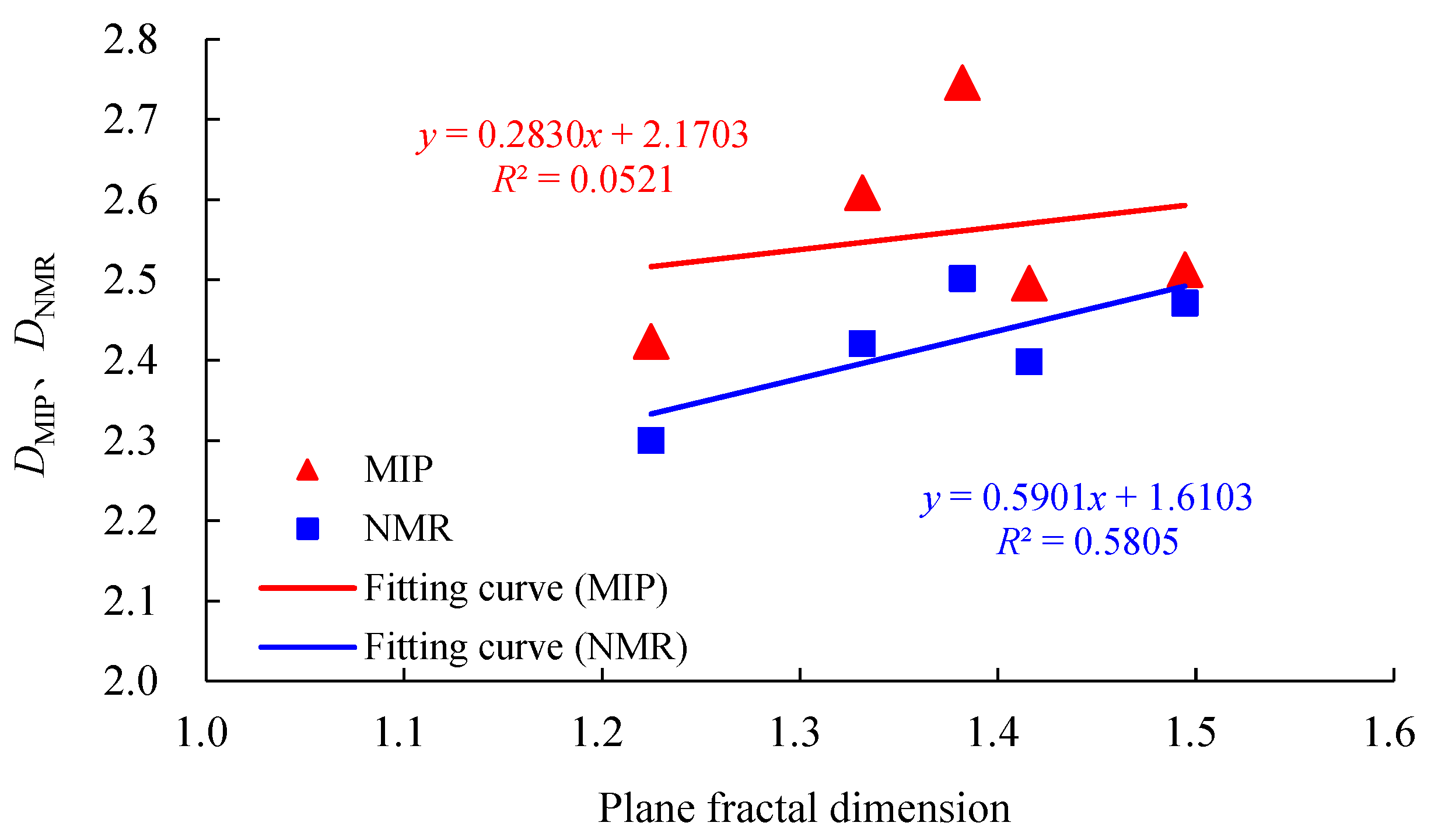
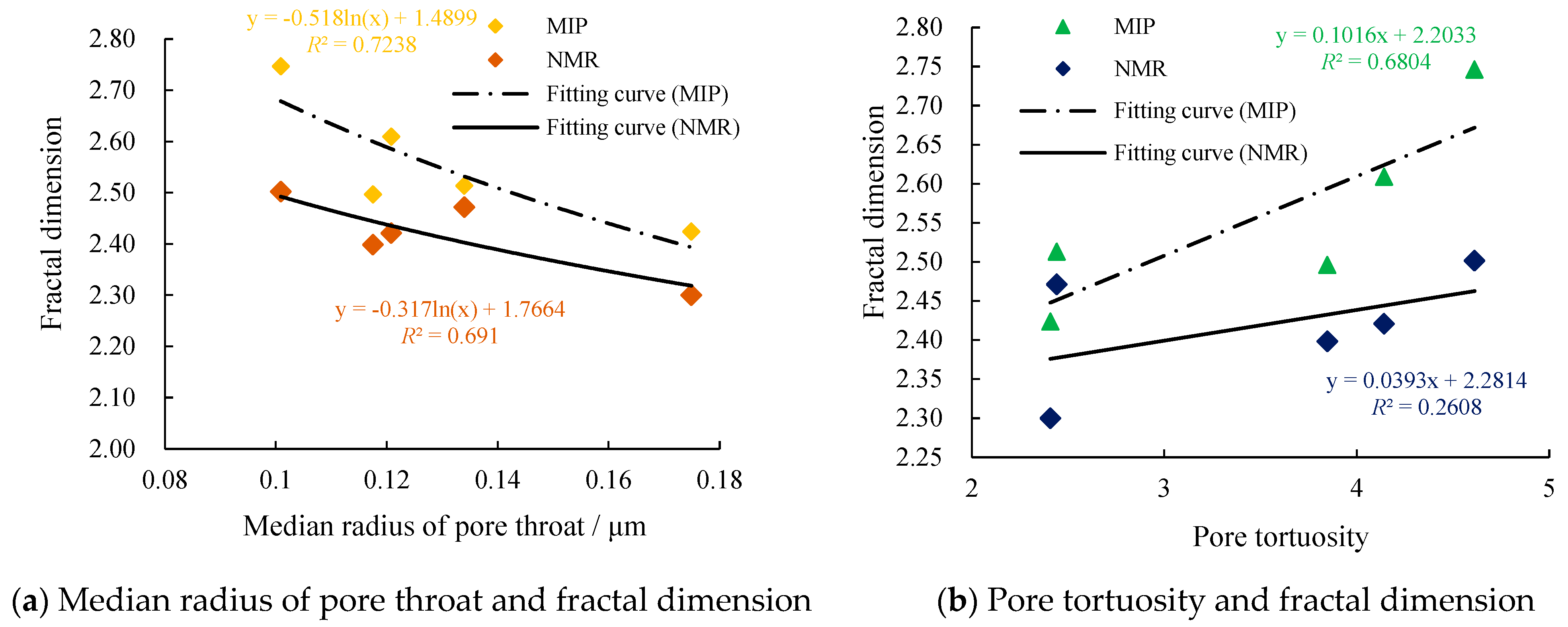

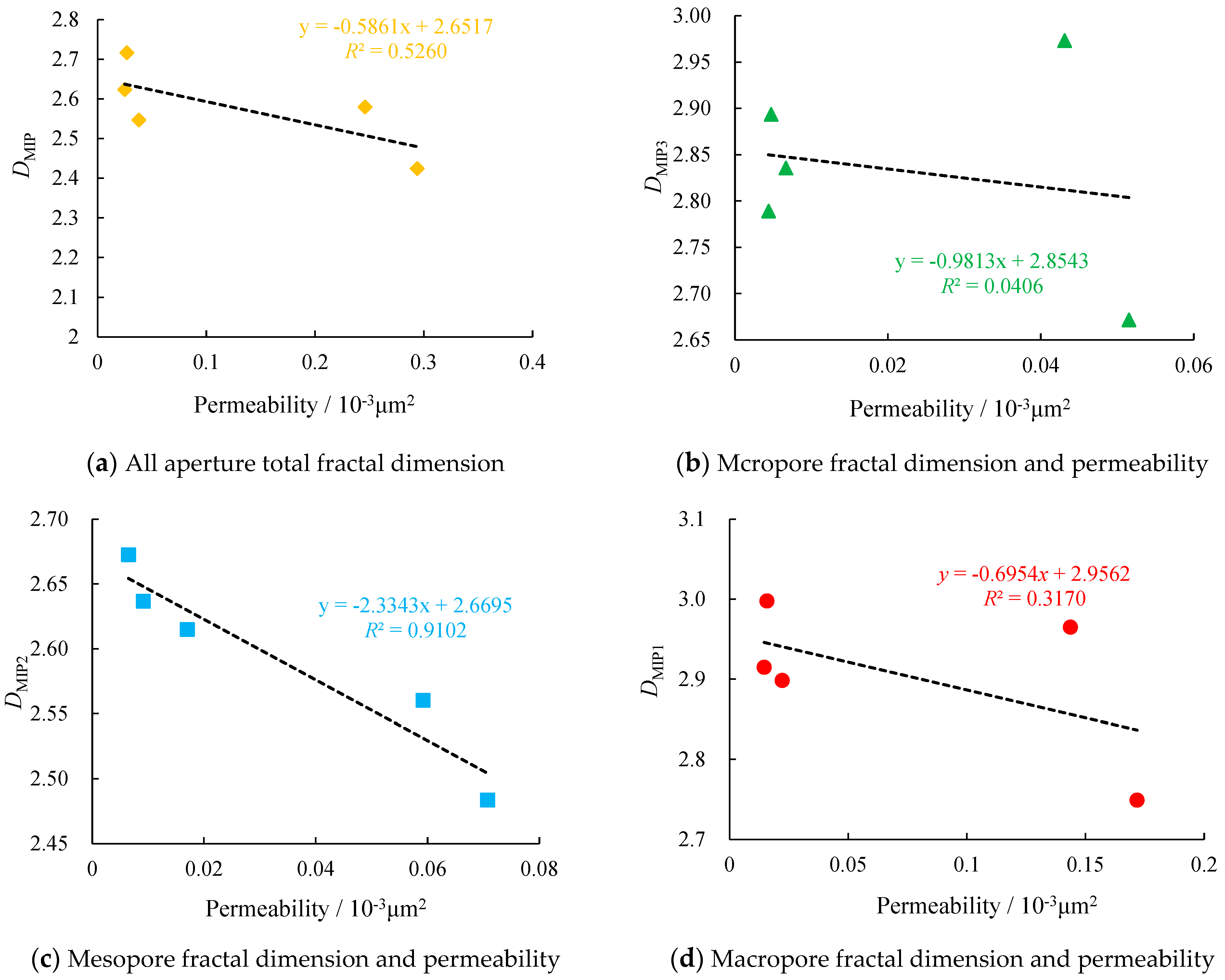
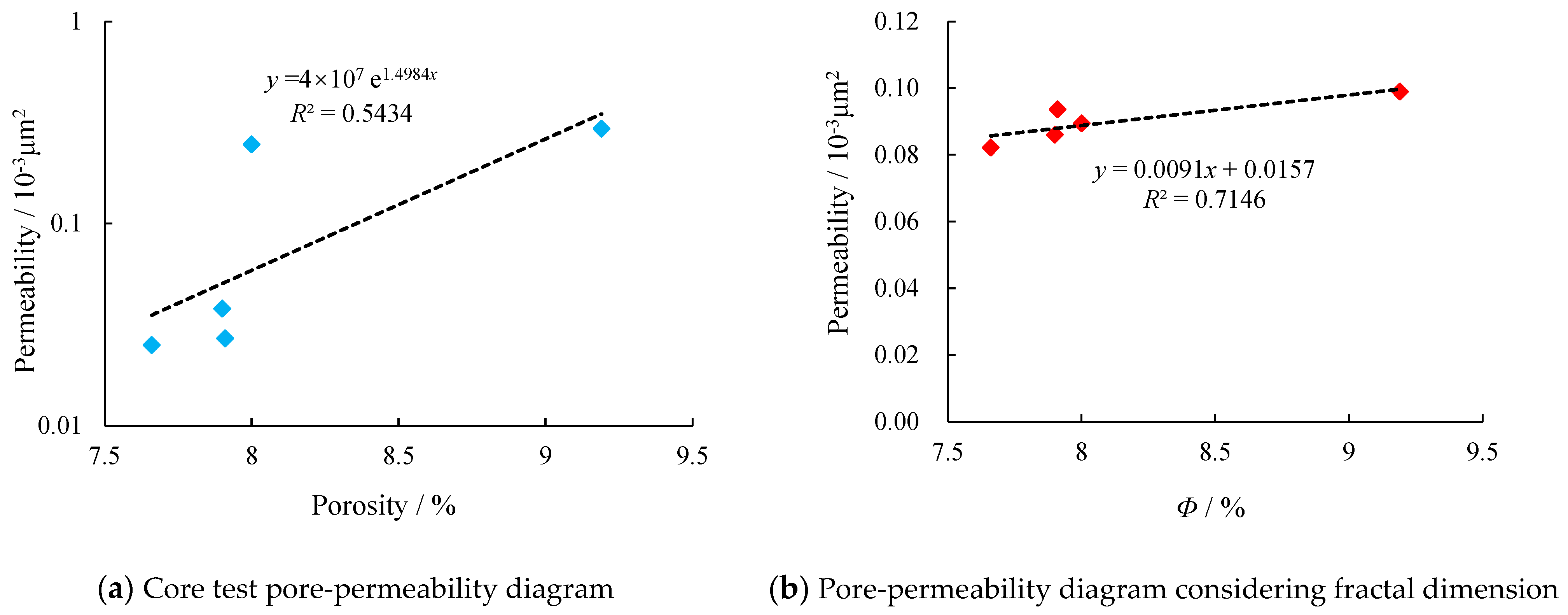
| No. | Radius/cm | Length/cm | Depth/m | Porosity/% | Permeability/10−3 μm2 | Lithology Description | Comment |
|---|---|---|---|---|---|---|---|
| E-1 | 2.50 | 2.36 | 3470.17 | 9.19 | 0.294 | Light grayish-brown limestone | |
| E-2 | 2.52 | 2.94 | 3300.82 | 8.02 | 0.246 | Light gray silky limestone | |
| D-1 | 2.52 | 3.08 | 3324.54 | 7.66 | 0.025 | Brownish-gray silky limestone | Multiple groups of inclined fracture were developed |
| F-1 | 2.50 | 2.96 | 3357.18 | 7.90 | 0.038 | Light brown gray limestone | A high Angle fracture is developed |
| F-2 | 2.51 | 3.05 | 3244.04 | 7.91 | 0.027 | Light brownish gray bioclastic limestone |
Disclaimer/Publisher’s Note: The statements, opinions and data contained in all publications are solely those of the individual author(s) and contributor(s) and not of MDPI and/or the editor(s). MDPI and/or the editor(s) disclaim responsibility for any injury to people or property resulting from any ideas, methods, instructions or products referred to in the content. |
© 2024 by the authors. Licensee MDPI, Basel, Switzerland. This article is an open access article distributed under the terms and conditions of the Creative Commons Attribution (CC BY) license (https://creativecommons.org/licenses/by/4.0/).
Share and Cite
Cheng, Y.; Luo, X.; Zhuo, Q.; Gong, Y.; Liang, L. Description of Pore Structure of Carbonate Reservoirs Based on Fractal Dimension. Processes 2024, 12, 825. https://doi.org/10.3390/pr12040825
Cheng Y, Luo X, Zhuo Q, Gong Y, Liang L. Description of Pore Structure of Carbonate Reservoirs Based on Fractal Dimension. Processes. 2024; 12(4):825. https://doi.org/10.3390/pr12040825
Chicago/Turabian StyleCheng, Youyou, Xiang Luo, Qingong Zhuo, Yanjie Gong, and Liang Liang. 2024. "Description of Pore Structure of Carbonate Reservoirs Based on Fractal Dimension" Processes 12, no. 4: 825. https://doi.org/10.3390/pr12040825




